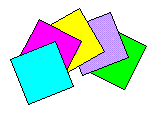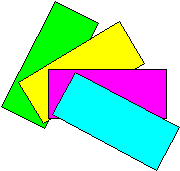This page introduces various
rectangles that are of proven (or potential) use
as starting shapes in origami (and particularly
in modular origami) and briefly discusses their
most useful folding geometries.
Folding geometries are of two quite
distinct kinds, natural and embedded. The
difference between these two types of folding
geometry is explained in Folding Geometries and
Angular Systems.
Whilst all folding geometries can
(at least in theory) be obtained from all paper
shapes, the optimum folding solution for a
particular design will usually be found by
starting from the paper shape that most naturally
yields the angles required.
In modular origami rectangular paper
shapes are often used in double or double-strip
form. A double rectangle is made by joining two
rectangles along their longer edges, a
double-strip rectangle by joining two rectangles
along their shorter edges. Designs made from
triple and triple-strip rectangles etc are also
occasionally found.
|
| |
 |
|
The
square is undoubtedly the most
versatile starting shape in origami, to
the extent that some paperfolders (even
some modular paperfolders) use no other
(with the unfortunate result that it is
quite often possible to improve the
elegance of their designs by the simple
expedient of switching to a more
appropriate paper shape). |
|
| |
| The
natural folding geometry of the square produces
angles of 90 and 45 degrees. This system of
angles can be called standard folding geometry.
It is easy to embed standard folding geometry
within any other paper shape, no matter how
unusual or irregular the shape may be. The versatility of
the square arises because it is particularly easy
to embed the folding geometry of most other
useful rectangles within it. The square can also
easily be divided into a number of standard grids
of smaller squares or silver triangles, many of
which form the basis for a whole range of related
designs.
|
| |
| The
silver rectangle (also known as
the pure or DIN rectangle) has sides in
the proportion of 1:sqrt2 and has the
unusual property that it is its own
double. The natural folding geometry
of the silver rectangle yields angles of
approximately 110, 70 and 55 degrees.
These angles are found in the structure
of the tetrahedron, the cube and the
cuboctahedron as well as in the many
interesting forms known as rhombic
polyhedra.
A4
paper is a good approximation of a silver
rectangle.
|
|
 |
|
| |
 |
|
The bronze rectangle
has sides in the proportion of 1:sqrt3
and its natural folding geometry yields
angles of 120, 60 and 30 degrees. The
bronze rectangle is its own triple. The bronze
rectangle is, at present, rather
under-used in modular origami design,
perhaps because bronze rectangle geometry
can so easily be embedded into any other
rectangle.
|
|
| |
| The
leftover rectangle is the
rectangle left over when the largest
possible square is removed from a silver
rectangle. The leftover rectangle has
sides in the proportion of 1:1+sqrt2 and
naturally yields angles of 135, 67.5 and
45 degrees.
The
potential of this rectangle (which is
often produced in quantity when cutting
squares from A4) is still largely
unexplored.
The
natural folding geometry of the leftover
rectangle is also natural to the silver
rectangle and easily embedded in the
square.
|
|
 |
|
| |
 |
|
The
twin platinum rectangles (the
rectangles which contain the twin
golden-proportion triangles arranged apex
to apex) naturally yield the 108, 72 and
36 degree angles required to model
polygons and polyhedra related to the
regular pentagon. The platinum
rectangles are, however, at present,
little used in origami design, since it
is easy to generate, or closely
approximate, a similar folding geometry
from the 3x1 or 2x3 rectangles and the
square.
|
|
| |
| The golden rectangle
has sides in the golden proportion of
1:1.618 approximately. There are
only a few modular origami designs which
make use of the natural folding geometry
of this rectangle.
|
|
 |
|